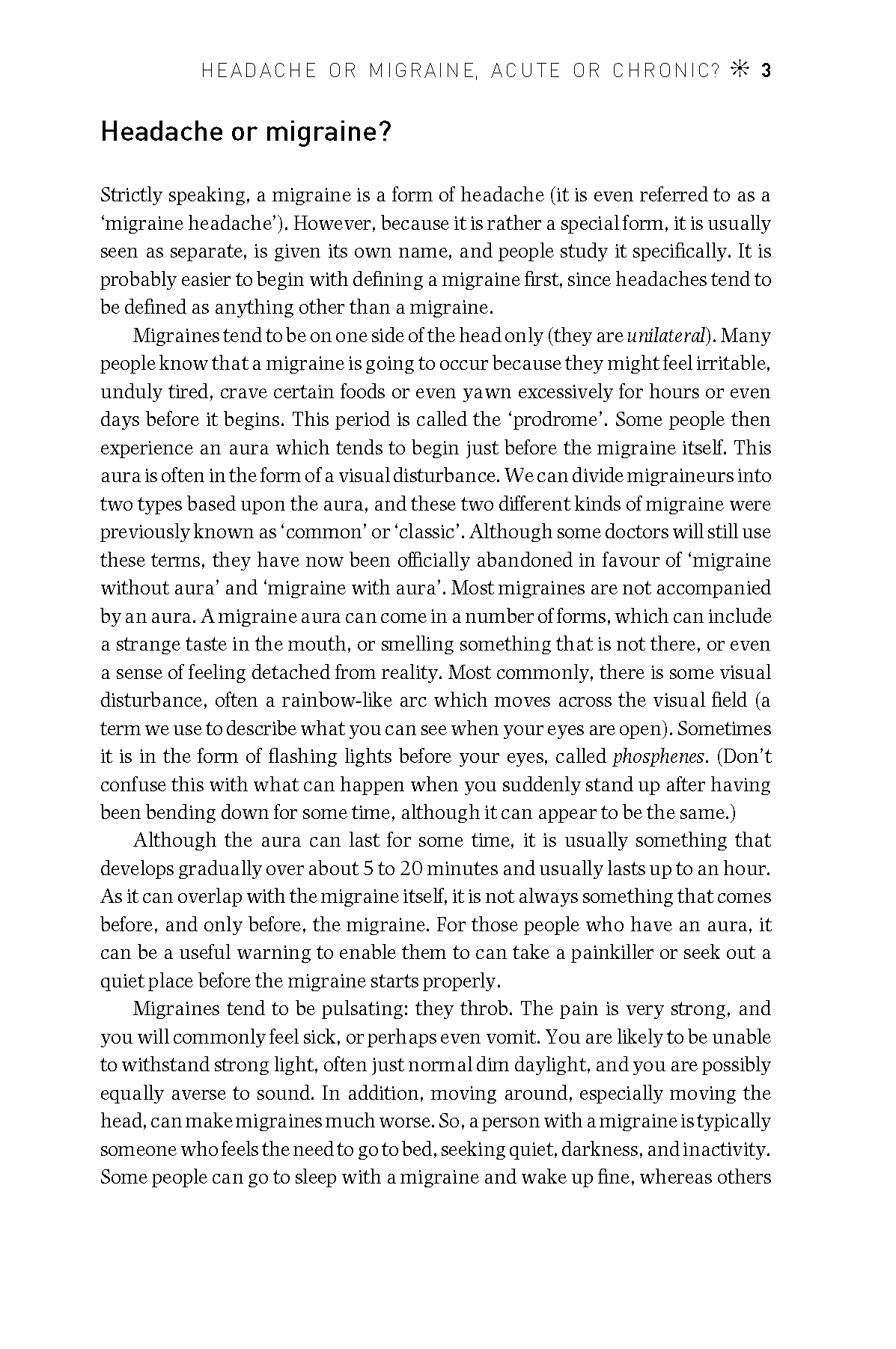UHAM020

HEADACHE OR MIGRAINE, AC UTE OR CHRONIC? ^ 3
Headache or migraine?
Strictly speaking, a migraine is a form of headache (it is even referred to as a ‘migraine headache’). However, because itisrather a specialform, it is usually seen as separate, is given its own name, and people study it specihcally. It is probably easier to begin with dehning a migraine first, sińce headaches tend to be dehned as anything other than a migraine.
Migraines tend to be on one side ofthe headonly (they areunilateral). Many people know that a migraine is going to occur because they might feel irritable, unduly tired, crave certain foods or even yawn excessively for hours or even days before it begins. This period is called the ‘prodrome’. Some people then experience an aura which tends to begin just before the migraine itself. This aura is often in the form of a visual disturbance. We can divide migraineurs into two types based upon the aura, and these two different kinds of migraine were previously known as ‘common’ or ‘classic’. Although some doctors will still use these terms, they have now been officially abandoned in favour of ‘migraine without aura’ and ‘migraine with aura’. Most migraines are not accompanied by an aura. A migraine aura can come in a number of forms, which can include a strange taste in the mouth, or smelling something that is not there, or even a sense of feeling detached from reality. Most commonly, there is some visual disturbance, often a rainbow-like arc which moves across the visual field (a term we use to describe what youcan see when your eyes are open). Sometimes it is in the form of flashing lights before your eyes, called phosphenes. (Don’t confuse this with what can happen when you suddenly stand up after having been bending down for some time, although it can appear to be the same.)
Although the aura can last for some time, it is usually something that develops gradually over about 5 to 20 minutes and usually lasts up to an hour. As it can overlap with the migraine itself, it is not always something that comes before, and only before, the migraine. For those people who have an aura, it can be a useful warning to enable them to can take a painkiller or seek out a ąuiet place before the migraine starts properly.
Migraines tend to be pulsating: they throb. The pain is very strong, and you will commonly feel sick, or perhaps even vomit. You are likely to be unable to withstand strong light, often just normal dim daylight, and you are possibly eąually averse to sound. In addition, moving around, especially moving the head, can make migraines much worse. So, a person with a migraine istypically someone whofeelstheneedto gotobed, seeking ąuiet, darkness, andinactivity. Some people can go to sleep with a migraine and wake up hne, whereas others
Wyszukiwarka
Podobne podstrony:
UHAM022 HEADACHE OR MIGRAINE, AC UTE OR CHRONIC? * 5 A headache which feels Like a tight band is aro
UHAM026 HEADACHE OR MIGRAINE, AC UTE OR CHRONIC? * 9Points to notę • Headaches are
UHAM024 HEADACHE OR MIGRAINE, AC UTE OR CHRONIC? * 7 at 18; for other things you are considered able
skanuj0173 „Strategie mangement is a stream of decisions and actions which leads to the development
img027 3 250 NECLIGENCE: CAUSATION AND CONTRIBUTORY NEGLIGENCE 1979) or from a contractual obligatio
skanuj0010 G present simple or present continuous? V places in a city P citynamesWhen a man is
Poetry 3 1 POETRY 3 I. The form of poetry - sound values: - RHYME - agreement in sound between words
• ensuring that the person in charge of a unit, plant or installation is aware of
not to be satisfactory explained, or technically overcome, without a de-tailed knowledge of the grał
skanowanie0027(1) Complete the corwersation. Use will, be going to or a present tense. Choose the be
m3374 tor being almost any form of tower, a bastida being a new village or town that need not be for
figury *Co!or, cut out and mount to inside of folder. ® Carson-Dellosa Publ. CD-2013 271
Rutę 14-3 Wearing Headphones or Earplugs During Stipulated Round The use of headphones or earplugs t
więcej podobnych podstron